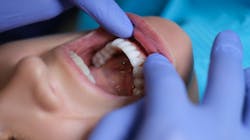Composite veneers have been around a long time. They were initially individually handcrafted and still are by many talented dentists. This process requires a lot of time, skill, and knowledge to produce a great outcome. Patients are generally satisfied, but composite veneers still have quite a few shortcomings due to the variability of the dentist’s skill set and the patient’s expectations.
Using digital technology, we can now create smiles with predictable composite veneers that patients can preview in their mouth prior to treatment acceptance. This allows us to be more efficient and consistent in providing composite veneer treatment, which significantly reduces chair time and remakes, and results in predictable outcomes for the patient and dentist. Everyone wins in this scenario.
Composite resin or porcelain?
Composite resin and porcelain are the most commonly used materials for fabricating veneers. Both materials can yield beautiful results. Which material is correct for your patient? This comes down to the patient’s desires, treatment limitations, and budget, along with the diagnostic abilities of the dentist. Here are some of the differences between the materials.
Advantages
Given that veneers are considered a cosmetic procedure by most dental insurance plans, they will not assist in paying for this procedure. So, cost can be a major limiting factor of case acceptance. Composite may be used to help reduce the expense to the patient if any necessary laboratory work can be done in-house. The number of teeth in smile makeover cases can add up quickly if we’re doing the maxillary anteriors and first premolars or more, so the savings can be significant for the patient. Be aware that if you are doing freehand composite veneers, the chairside time needed to do the procedure well can be substantial. This can raise costs for the patient.
Smile makeover: A minimally invasive recipe for esthetic success
Increase your service and revenue with elective dental procedures
Another advantage that composite veneers have over porcelain is that composite veneers can typically be fabricated in a single visit. This is where the skill of the dentist becomes increasingly important. Determining shades, translucency, and shape are all part of the process. Upon completion, the resin must be polished to elicit a more natural, toothlike appearance. The composite procedure therefore may be much less invasive and noticeably quicker than porcelain veneers.
Arguably the biggest advantage that composite veneers have over porcelain is that preparation may be less invasive and perhaps reversible. If there are potential occlusal issues, the ability to repair composite intraorally allows us to potentially test a case before committing to doing porcelain veneers.
Disadvantages
One of the disadvantages of composite veneers is that they have a shorter cosmetic lifetime compared to porcelain. Even when polished well, composite veneers can still be more prone to staining over time depending on the patient’s habits and diet. This can be mitigated to some extent by fabricating the patient bleaching trays after the veneers are placed and having the patient whiten their teeth if they start to stain over time.
Treatment process
Now that we know the benefits and limitations of composite veneers, how do we incorporate state-of-the-art treatment to maximize our ability to provide treatment efficiently with good outcomes? We start with a matrix.
Digital or analog impressions (which are digitized) are taken for the pre-op so we can come up with an appropriate treatment plan. From these models, we can do a digital wax-up for the new smile. 2D images can be emailed to the patient so they can visualize the proposed outcome. Each part of the process should be billed so you don’t waste money on patients who are just shopping for a change. The patient’s payment is their commitment at each step that they are serious about moving forward with treatment.
Once the patient approves of the 2D images, the model can then be printed and a stent fabricated from the digital wax-up. This proposed smile can be transferred to allow for a pre-op try-in of the new smile using a temporary crown and bridge resin. Allowing patients to view the proposed treatment in their mouth is an important step to ensure they’re happy with the proposed smile enhancements and fully consent to treatment.
Once the patient consents to moving forward with treatment, the dentist can use this appointment to assess the smile balance, occlusal function, and interferences. Small changes can be incorporated into the final fabrication of the composite veneers. Patients may choose to whiten their teeth while the final is sent to the lab to be fabricated. This is another opportunity for the dentist to produce additional income for the case, since patients will want to have lighter teeth that may not be part of the proposed case.
Once the final stents are delivered, the patient will present for finalization of the case. The patient will be anesthetized, and the stent will be tried in. Using standard bonding protocols, the stent is seated and the flowable resin is then injected into the tray and resin-cured. Issues with this type of fabrication include the flowable resin not being as strong and having less wear resistance compared to nonflowable resins. Finishing the case can be tedious because the teeth have not been separated; it takes a lot of time to finish proper postcuring of the resin.
Recently another unique method was developed by a UK company called SmileFast. The stent is fabricated with thin metal separators embedded into the tray. Your favorite nonflowable composite resin can then be heated to obtain the lower viscosity needed for the resin to flow. The heated composite is placed into the tray, and the tray is inserted with the separators in place. The resin is cured, and the stent is removed. The teeth are not bonded together!
We have used a better resin material compared to flowable resin, getting stronger composite veneers with better polishability. With the SmileFast technique, you get all the benefits of the flowable composite injectable technique while being more efficient in finishing the case with your favorite superior nonflowable composite—and the patient gets a more esthetic outcome.
Insurance coding
If you decide to maximize the patient’s insurance benefits, use CDT code D2960—Labial veneer (resin laminate) chairside. This code is usually considered cosmetic in nature. There may be exceptions for previously placed dental work or genetic issues. There are usually plan limitations for the code, and reimbursement for this procedure will be inconsistent.
When submitting for this code, make sure you document appropriately with a narrative and photographs. Be aware that if you participate with insurance, fee limits may be imposed. It may be prudent to have the patient sign an insurance release or send a predetermination of benefits prior to starting the procedure.
Composite veneers are coming back in vogue due to advances in digital technology. With this modern approach, we can more predictably enhance a patient’s smile with minimal biologic risk to the teeth, as well as have very predictable function and esthetics.
Editor's note: This article appeared in the February 2023 print edition of Dental Economics magazine. Dentists in North America are eligible for a complimentary print subscription. Sign up here.
About the Author
Marty Jablow, DMD
Marty Jablow, DMD, is America’s Dental Technology Coach. A 1986 graduate of Rutgers Dental School, he practices in Woodbridge, New Jersey. He is a member of the Cellerant Best of Class selection committee, charged with the annual selection of industry awards, and is the chief development officer of Cellerant Consulting. Dr. Jablow has received fellowships from the Academy of General Dentistry and the International Association of Dental-Facial Esthetics. He is a member of the American Dental Association and the New Jersey Dental Association.
Updated January 11, 2023

